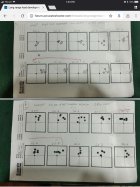I have done ladder tests for years and it makes some sense to me. However, it has always been on medium size caliber to 7MMRM. I have a friend with a 223 Rem and we intend to hand load for him. I have never done such a small case before. I intend to teach him how to hand load.
This has created some new questions. I have watched and read many stories from top shooters who use the "OCW" process. And I have read the instructions for the OCW method. So we decided that because we are starting from scratch we will follow the OCW instructions. Therefore I dug deeper into the methodology.
I find something interesting that does not make sense to me.
The table created looks like this.
The formulas work just fine. But my question is:
I hope I'm clear. Can someone enlighten me? Thanks
Corrected. I missed my decimal on the grain increments.
This has created some new questions. I have watched and read many stories from top shooters who use the "OCW" process. And I have read the instructions for the OCW method. So we decided that because we are starting from scratch we will follow the OCW instructions. Therefore I dug deeper into the methodology.
I find something interesting that does not make sense to me.
The table created looks like this.
| Minimum | 23.5 | |
| Maximum | 24.9 | |
| Rnd 10 | 24.9 | -E21 the MAXIMUM Load |
| Rnd 9 | 24.8 | =G28*(1-0.5%) |
| Rnd 8 | 24.7 | =F28*(1-0.5%) |
| Rnd 7 | 24.5 | =F28*(1-0.5%) |
| Rnd 6 | 24.4 | =D28*(1-0.7%) |
| Rnd 5 | 24.2 | =C28*(1-0.7%) |
| Rnd 4 | 23.9 | =G26*(1-1%) |
The formulas work just fine. But my question is:
- What is the logic to take the % reduction from 0.5% to 1% ?
- What is the logic in this format to be the same for a 223, a 7mmRM and a 338? My simple math says that any percentage change will have a significant difference between cases of different volumes. Therefore the percentage shift should be based on relative case size. +/-
I hope I'm clear. Can someone enlighten me? Thanks
Corrected. I missed my decimal on the grain increments.
Last edited:











